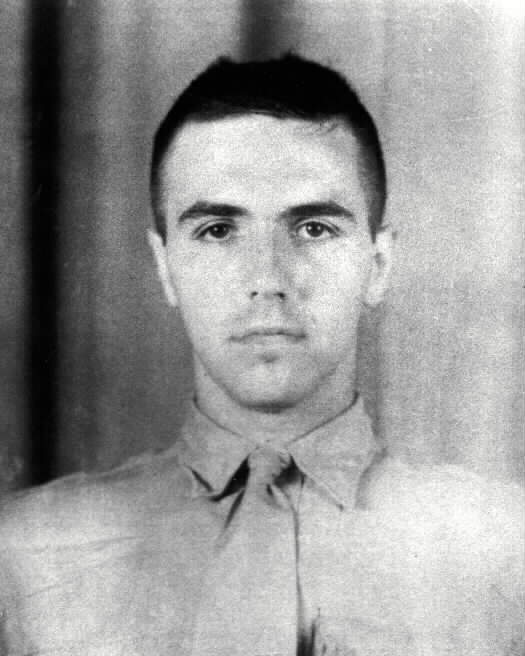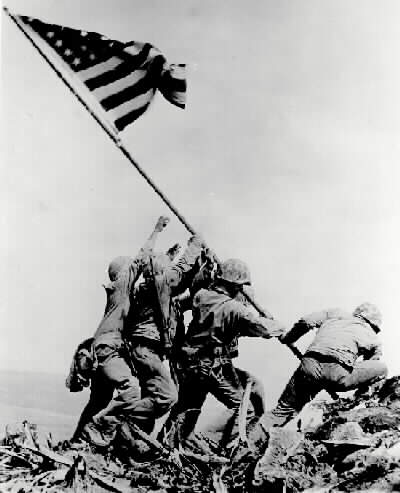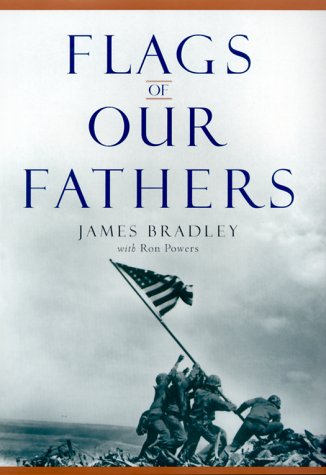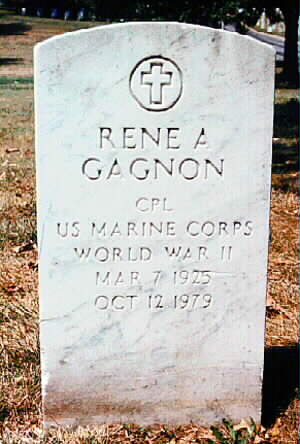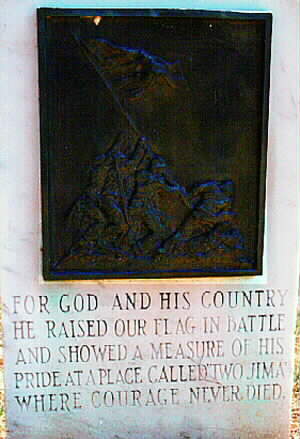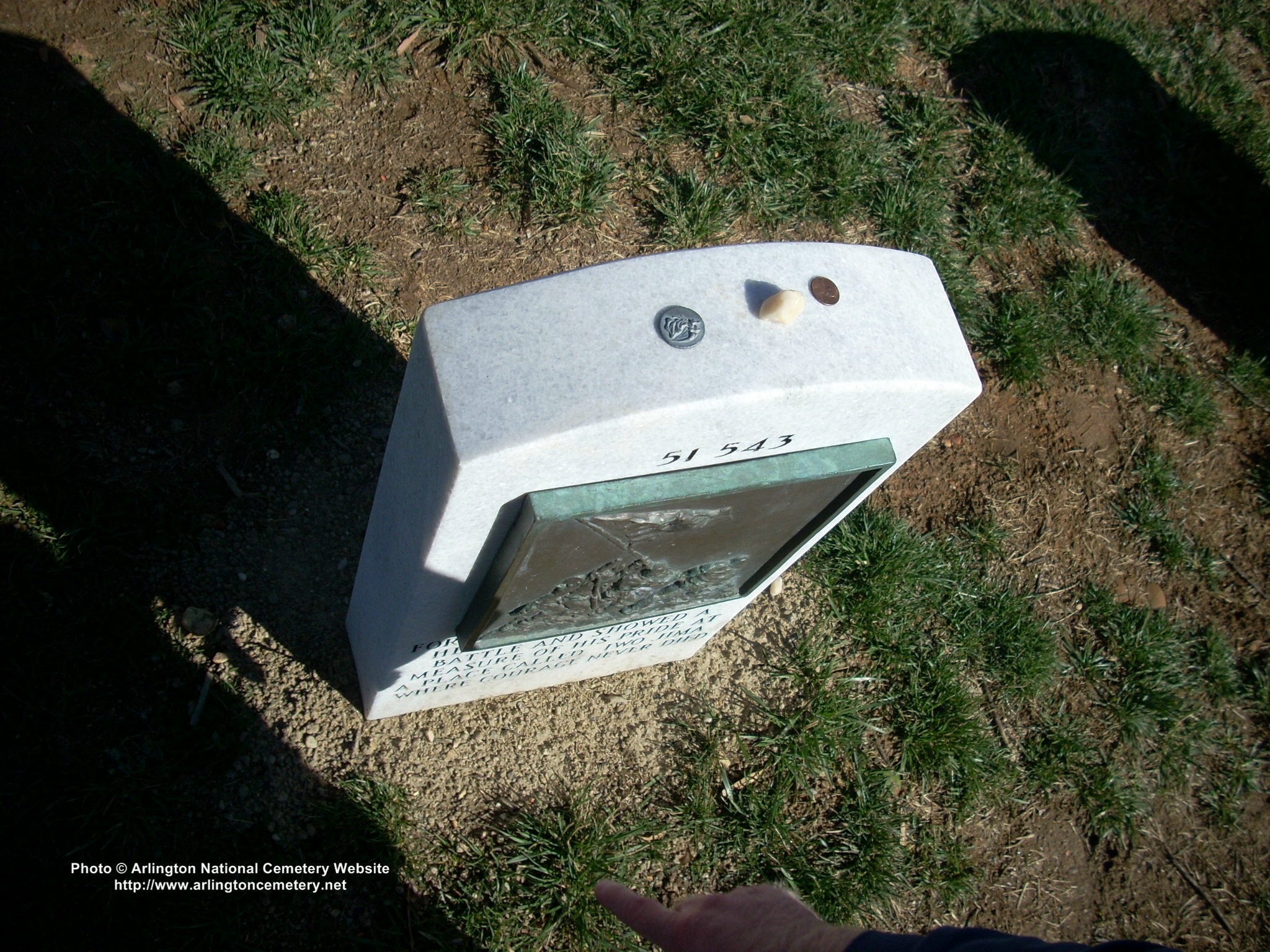Courtesy of the United States Marine Corps
Rene Arthur Gagnon, participant in the famous flag raising on Iwo Jima, was born at Manchester, New Hampshire, on 7 March 1926. He attended the schools of Manchester and completed two years of high school before leaving to take a job with a local textile mill. On 6 May 1943, he was inducted into the Marine Corps Reserve and sent to Marine Corps Recruit Depot, Parris Island, South Carolina.
From Parris Island, Private First Class Gagnon, promoted on 16 July 1943, was transferred to the Marine Guard Company at Charleston, South Carolina, Navy Yard. He remained there for eight months and then joined the Military Police Company of the 5th Marine Division at Camp Pendleton, Oceanside, California. Four days later, on 8 April, he was transferred to Company E, 2d Battalion, 28th Marines.
After training at Camp Pendleton and in Hawaii, Gagnon landed with his unit on Iwo Jima on 19 February. After Iwo Jima was secured, he was ordered to Washington, D.C. arriving on 7 April. Together with the other two survivors of the flag raising, Pharmacist’s Mate John Bradley and Private First Class Ira Hayes, he was assigned to temporary duty with the Finance Division, U.S. Treasury Department, for appearances in connection with the Seventh War Loan Drive.
He finished the tour on 5 July and was ordered to San Diego for further transfer overseas. Private First Class Gagnon was married to Miss Pauline Georgette Harnois, of Hooksett, New Hampshire, in Baltimore, Maryland, on 7 July.
By September, he was on his way overseas again, this time with the 80th Replacement Draft. On 7 November 1945, he arrived at Tsingtao, China, where he joined Company E, 2d Battalion, 29th Marines, 6th Marine Division. He later served with the 3d Battalion of the same regiment.
On duty with the U.S. occupation forces in China for nearly five months, Private First Class Gagnon boarded ship at Tsingtao at the end of March 1946, and sailed for San Diego, arriving on 20 April.
With nine days short of three years’ service in the Marine Corps Reserve, of which 14 months was spent overseas, Gagnon was promoted to corporal and discharged on 27 April 1946. He was entitled to wear the Presidential Unit Citation with one star (for Iwo Jima), the American Campaign Medal, the Asiatic-Pacific Campaign Medal with one star (for Iwo Jima), the World War II Victory Medal, and the China Service Medal.
Corporal Gagnon died on 12 October 1979 in Manchester, New Hampshire, and was buried at Mount Calvary Mausoleum. At his widow’s request, Gagnon’s remains were reinterred in Arlington National Cemetery on 7 July 1981.
He died At home, Hooksett, New Hampshire, October 12, 1979. He was one of the U.S. servicemen who raised the flag on Iwo Jima on February 23, 1945. He was brought to the United States for a publicity tour and to encourage sale of war bonds. He later served in China until discharged. He was originally buried in Mount Cavalry cemetery in his hometown. He was ineligible for burial in Arlington National Cemetery, but was granted a waiver on April 16, 1981, and moved to Section 51 of Arlington on July 7, 1981.
News Report:
October 28, 1990: The widow of one of six US servicemen immortalized as they raised the American flag on Iwo Jima during WWII faces eviction from the home the war hero helped build 40 years ago.
Pauline Gagnon had planned to turn the home, which includes her travel agency, into a museum for her husband’s pictures, war medals and a flag that flew over Iwo Jima. But she ran into financial trouble, and the house was sold at a foreclosure auction during the summer. She’s been living there while she fights in court to overurn the sale.
Her troubles are the latest for the family of war hero Rene Gagnon, who died of a heart attack at age 54 in 1979.
Gagnon, who once said being a war hero was a blessing and a curse, was troubled by alcohol abuse throughout his life. His drinking got him fired from one job on Memorial Day in 1978. In an interview Pauline Gagnon said her husband was proud of the home and would be heartbroken to see it taken from her.
The photograph of her husband and his companions struggling to raise the flag still is on display in the house. She said her husband, a Marine, never overestimated his wartime contribution, despite the celebrity it brought him. “He said he just did his job,” she said. “They just said, Go do it,’ and he did.”
According to accounts from Iwo Jima, three Marines were trying to hoist the makeshift flagpole on February 23, 1945, but it was too heavy. Two more joined in, and then someone called Gagnon. As the six raised the pole, Associated Press photographer Joe Rosenthal took what became the most famous photograph of the war. It became the model for the Iwo Jima Memorial near Arlington National Cemetery. The memorial commemorates the 5,931 Marines who died taking the Pacific island.
Pauline Gagnon, who declined to give her age, blamed her current plight on a slowing economy and an overzealous buyer. She mortgaged her home when her business slowed, saying she planned to pay off the mortgage by selling some of the land. She couldn’t win approval of her plans. She maintains in court that Resource Financial Group, which sold the mortgage, and 2 women who bought it took advantage of her plight. She has asked the court to reverse the sale and release her from the mortgage.
Born on March 7 1926 in New Hampshire, he was one of the U.S. servicemen who raised the American flag on Mount Suibachi over the Island of Iwo Jima while the battle was raging there on February 23, 1945 during World War II.
He was brought back to the United States for a publicity tour and to encourage the sale of war bonds. He later served in China until his discharge from the Marine Corps.
The famous photograph of the raising appeared on both U.S. postage stamps and war bonds and is the subject of the Marine Corps War Memorial adjacenet to Arlington National Cemetery.
He died at Hooksett, New Hampshire, on October 12, 1979 after having suffered from years of alcoholism and unemploment that his family attributed to his unwanted fame. He was originally buried in Mount Calvary Cemetery in his hometown because his was technically inelligible for burial in Arlington. However, a waiver was granted on April 16, 1981 and he was reinterred in Section 51 of Arlington National Cemetery on July 7, 1981.
Two other “flag-raisers” are buried in Arlington: Sergeant Michael Strank and Corporal Ira Hamilton Hayes.
The youngest of the flag-raisers, and the one who actually carried the flag up Mount Suribachi, Rene Arthur Gagnon was not quite 19 when the famous photo was taken. He was born at Manchester, New Hampshire, on 7 March 1926, the son of Henry Gagnon and Irene Yvonne Gagnon. He attended the schools of Manchester and completed two years of high school before leaving to take a job with a local textile mill. On 6 May 1943, he was inducted into the Marine Corps Reserve and sent to Marine Recruit Depot, Parris Island, South Carolina.
From Parris Island, Private First Class Gagnon, promoted on 16 July 1943, was transferred to the Marine Guard Company at Charleston, South Carolina, Navy Yard. He remained there for eight months and then joined the Military Police Company of the 5th Marine Division at Camp Pendleton, Oceanside, California. Four days later, on 8 April, he was transferred to Company E, 2d Battalion, 28th Marines.
After training at Camp Pendleton and in Hawaii, gagnon landed with his unit on Iwo Jima on 19 February. After Iwo Jima was secured, he was ordered to Washington, arriving 7 April. Together with the two other survivors, Pharmacist’s Mate Bradley and Private First Class Hayes, he was assigned to temporary duty with the Finance Division, U.S. Treasury Department, for appearances in connection with the Seventh War Loan Drive.
He finished the tour on 5 July and was ordered to San Diego for further transfer overseas. Private First Class Gagnon was married to Miss Pauline Georgette Harnois of Hooksett, New Hampshire in Baltimore, Maryland on 7 July.
By September, he was on his way overseas again, this time with the 80th Replacement Draft. On 7 November 1945, he arrived at Tsingtao, China, where he joined Company E, 2d Battalion, 29th Marines, 6th Marine Division. He later served with the 3d Battalion of the same regiment.
On duty with the U.S. occupation forces in China for nearly five months, Private First Class Gagnon board ship at Tsingtao at the end of March and sailed for San Diego, arriving on 20 April.
With nine days short of three years’ service in the Marine Corps Reserve, of which 14 months was spent overseas, Gagnon was promoted to corporal and discharged on 27 April 1946. Corporal Gagnon died on 12 October 1979 in Manchester, New Hampshire and was buried at Mount Calvary Mausoleum. At his widow’s request, Gagnon’s remains were reinterred in Arlington National Cemetery on 7 July 1981. Rene is the flag raiser buried closest to the Marine Corps War Memorial (a.k.a. Washington Iwo Jima Statue.)
Corporal Gagnon was awarded the following decorations and awards:
Presidential Unit Citation with one star (for Iwo Jima);
American Campaign Medal;
Asiatic-Pacific Campaign Medal with one star (for Iwo Jima);
The World War II Victory Medal, and;
The China Service Medal.
One Moment of Glory
By Richard Harwood
Sunday , June 18, 2000
FLAGS OF OUR FATHERS
By James Bradley with Ron Powers
One of Washington’s premier landmarks is the world’s largest statue, an immense sculpture in bronze, weighing 100 tons and reaching a height of 110 feet. It depicts six Marines–each figure about 32 feet tall–hoisting an American flag on the island of Iwo Jima, a part of the prefecture of Tokyo, located in the Pacific Ocean 650 miles from the Japanese mainland.
The monument memorializes one of the final battles of the 20th century’s Second World War and has become, in the words of an academician, “one of the most charged and powerful cultural symbols of patriotism to mainstream Americans.” It was copied from a photograph made in February 1945 by Joe Rosenthal, an Associated Press photographer. The struggle ended a month or so later with more than 25,000 American Marines dead or wounded. The Japanese garrison of 22,000 was annihilated but for a few prisoners.
The flag-raising image, captured by Rosenthal in 1/400th of a second, had an adrenaline effect on a public tiring of war and haunted by fear that the approaching invasion of Japan would be Armageddon. Critics hailed the picture as a transcendent work of art. It inspired the sale of billions of dollars in war bonds and gave sculptor Felix de Weldon the blueprint for the huge statue that now looms alongside the Arlington National Cemetery. It made Rosenthal famous, brought sculptor de Weldon both fame and wealth, and gave the Marines a semi-religious institutional icon, a triumphant metaphor for the very soul of the Corps.
What has been lost in all this is any collective memory of the six boys who raised the flag and then, after an instant of notoriety, passed into the void of anonymity that, with few exceptions, awaits us all. Who were they? What happened to them?
The most recent of the many books inspired by the battle and by Rosenthal’s sublime image is Flags of Our Fathers, by James Bradley. It is described in a jacket blurb by the prolific military historian Stephen Ambrose as “the best battle book I have ever read.” Others may view it in that light, but that was not the author’s purpose. His principal aim was to rescue these forgotten boys–one of them his father–and transform them from “anonymous representative figures” into individuals.
His profiles of them resemble a cast from the paintings of Norman Rockwell, unfamous, un-celebrified, “ordinary” Americans: —Mike Strank, an immigrant from Czechoslovakia, brought to America in infancy by his father, who had found work digging coal in Pennsylvania for Bethlehem Steel.
—Ira Hayes, a “non-citizen” and immigrant of sorts in his native land, a Pima Indian born on a small cotton farm in the Gila River reservation in Arizona–geography his people had occupied for more than 2,000 years.
–Harlon Block, born on a farm in the Rio Grande valley of Texas, a superb athlete raised in a pacifist Seventh Day Adventist home where killing and even the possession of weapons were forsworn. “It is doubtful,” Bradley writes, “that in his short life Harlon Block ever kissed a girl.”
–Franklin Runyon Sousley, a good old hillbilly boy from Eastern Kentucky, a practical joker who, it was said, would “fight a running sawmill.” His father died when he was 8 years old, leaving him as the man in the family.
—Rene Gagnon, child of French Canadian mill workers in Manchester, N.H., a shy, self-conscious “mama’s boy” who “never chummed with the guys” and, like his parents, faced a lifetime in a factory until the Marines got him in 1943.
–Jack Bradley, father of the author of this book, an altar boy from a devout Catholic household in Antigo, Wis. His high school ambition (fulfilled after the war) was to be a funeral director, a counselor and friend to the bereaved. He joined the Navy to
avoid combat, wound up as a medical corpsman with the Marines and came home with a Navy Cross, an honor unrevealed to his family until after his death.
They were teenagers, Bradley writes, “scarcely out of boyhood when they enlisted. Their lives up till then had been kids’ lives: hunting, fishing, paper routes, the movies, adventure programs on radio . . . first wary contacts with girls . . . Most of them were poor. The Great Depression ran through their lives.” They grew up fast in the war, discovering that doing their duty to God and country involved unimagined pain, terrors and awful deeds.
On Feb. 23, 1945, the fifth day of the battle, they raised the second of two flags planted that morning on the summit of Mount Suribachi, an extinct volcano that overlooked the landing beaches and had been made by the Japanese into a hellish nest of gun emplacements, pillboxes, fortified caves, tunnels and storage depots.
A week later their outfit, Easy Company, Second Battalion, 28th Marines, joined an assault on another ugly, heavily fortified terrain. They came under heavy sniper fire. Mike Strank, now a sergeant, squad leader and father figure to Hayes, Block and Sousley, led them to cover under a rocky outcropping. A shell, almost certainly from an American destroyer lying offshore, exploded and tore out Strank’s heart. Harlon Block took over the squad. A few hours later a mortar round sliced him from groin to neck. As his intestines poured out on the ground he cried out: “They killed me.”
Easy Company moved on, losing men daily. Jack Bradley, the corpsman, was wounded by shrapnel and flown out to a hospital in Guam. Sousley was shot by a sniper. Someone shouted: “How ya doin’?” Sousley replied: “Not bad. I don’t feel anything.” Then he fell and died.
Ira Hayes left Iwo Jima unwounded and nine months later was a civilian again, leaving behind in a mass graveyard on the island the best friends he ever had–Mike and Harlon and Franklin. Back home he found menial jobs on the reservation–cotton picking and other day labor work. He became a drifter, drank a lot, was in and out of jail and died in an abandoned hut on the reservation after an all-night poker game in January 1955, just short of 10 years after the flag-raising. He was 32 and got the biggest funeral in the history of Arizona.
Rene Gagnon survived the war unharmed, tried to exploit his brief fame as a flag-raiser but never “made it” out of the New Hampshire rut into which he was born. He was a janitor at a tourist home when he died in 1979 at the age of 54. Jack Bradley died in 1994, patriarch of a large family, revered town father in Antigo and proprietor of one of the largest funeral businesses in Wisconsin.
None of their names is on the monument. You can find out more about them in James Bradley’s fine book.
Richard Harwood, a veteran of the Iwo Jima battle, is a former reporter, editor and columnist for The Washington Post.
Widow Of Iwo Jima Flag Raiser Dies
Couple Owned Travel Agency After War
January 20, 2006
MANCHESTER, NEW HAMPSHIRE – Pauline Gagnon, widow of one of the Marines immortalized in the Iwo Jima flag raising of World War II, has died at age 80.
The Manchester resident died Monday at Catholic Medical Center. A native of Pembroke, she had lived most of her life in Hooksett.
She was the widow of Rene Gagnon, who died in 1979 and was one of the Iwo Jima flag raisers immortalized in the 1945 Associated Press photograph by Joe Rosenthal. The photo came to symbolize the Marine Corps and Allied victory over Japan.
Five Marines and a Navy medic raised the flag during one of the bloodiest battles of the Pacific campaign.
The Gagnons owned and operated JubileeTravel Agency for 25 years.
A Mass of Christian Burial will be celebrated Saturday at 10 a.m. in St. Joseph Cathedral.
She will be buried Thursday in Arlington National Cemetery next to her husband.
She is survived by a son, four grandchildren, five great-grandchildren, a brother, two sisters and several nieces and nephews.
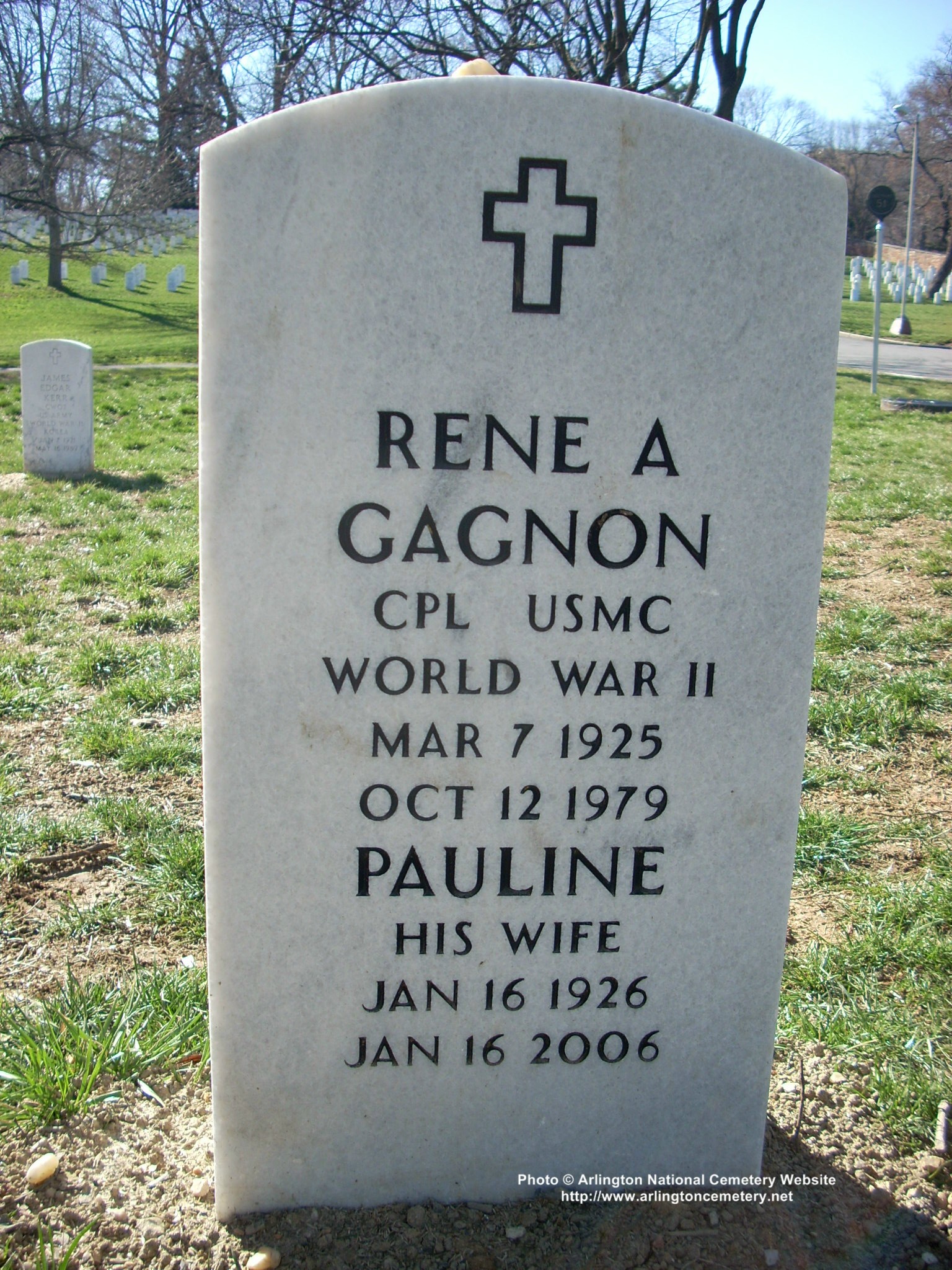
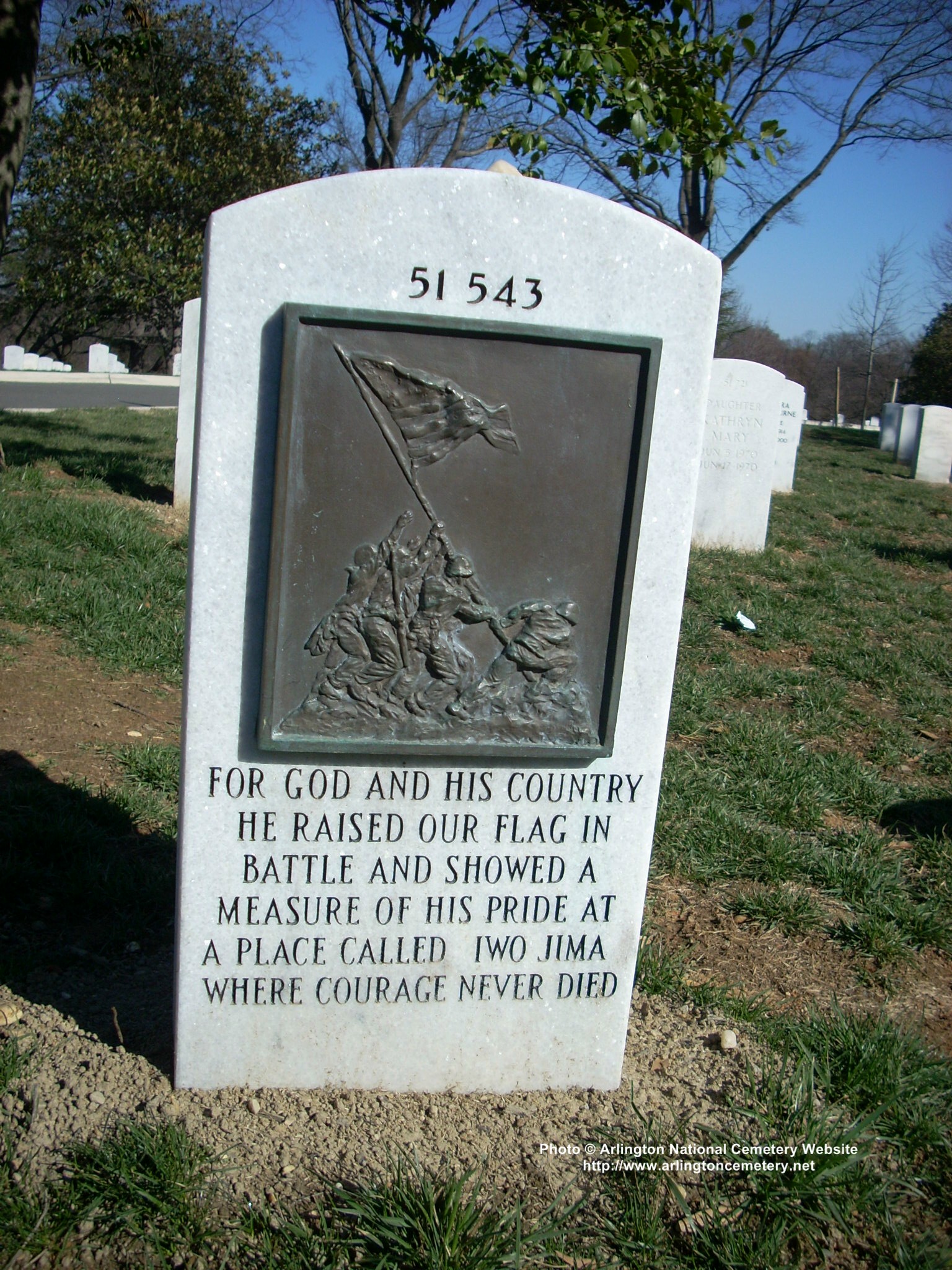
Michael Robert Patterson was born in Arlington and is the son of a former officer of the US Army. So it was no wonder that sooner or later his interests drew him to American history and especially to American military history. Many of his articles can be found on renowned portals like the New York Times, Washingtonpost or Wikipedia.
Reviewed by: Michael Howard

